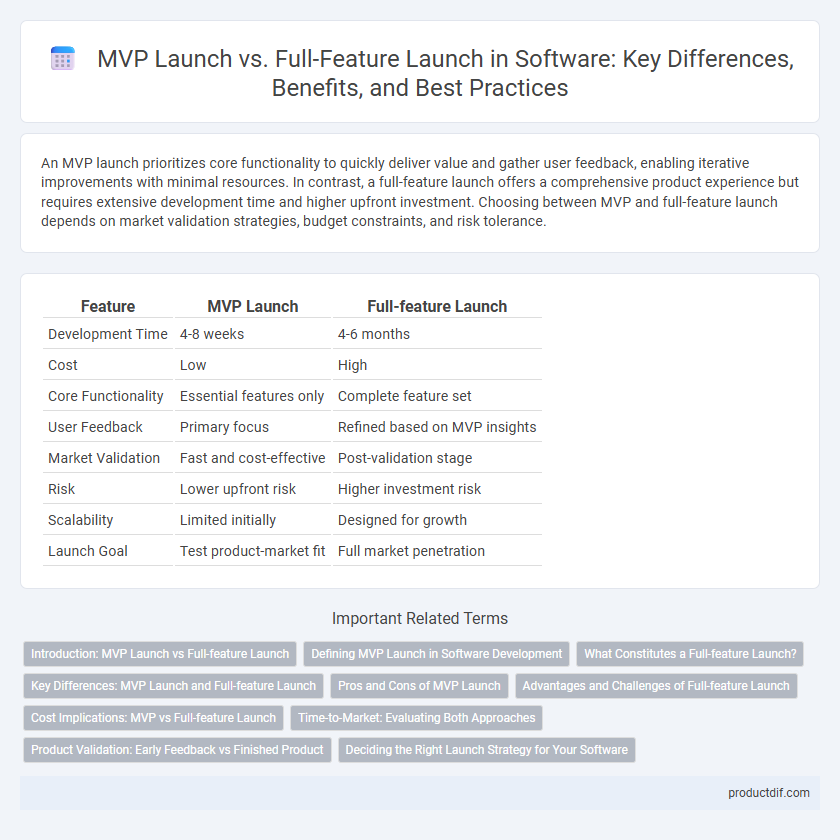An MVP launch prioritizes core functionality to quickly deliver value and gather user feedback, enabling iterative improvements with minimal resources. In contrast, a full-feature launch offers a comprehensive product experience but requires extensive development time and higher upfront investment. Choosing between MVP and full-feature launch depends on market validation strategies, budget constraints, and risk tolerance.
Table of Comparison
| Feature | MVP Launch | Full-feature Launch |
|---|---|---|
| Development Time | 4-8 weeks | 4-6 months |
| Cost | Low | High |
| Core Functionality | Essential features only | Complete feature set |
| User Feedback | Primary focus | Refined based on MVP insights |
| Market Validation | Fast and cost-effective | Post-validation stage |
| Risk | Lower upfront risk | Higher investment risk |
| Scalability | Limited initially | Designed for growth |
| Launch Goal | Test product-market fit | Full market penetration |
Introduction: MVP Launch vs Full-feature Launch
MVP launch prioritizes releasing a minimal set of core functionalities to rapidly validate market demand and gather user feedback. Full-feature launch delivers a comprehensive product with all planned features, aiming to provide a complete user experience from the start. Choosing between MVP and full-feature launch impacts development time, cost, and risk management in software projects.
Defining MVP Launch in Software Development
MVP launch in software development refers to releasing a product with the minimum set of core features necessary to satisfy early adopters and gather user feedback. This strategy enables rapid validation of product-market fit, reduces development costs, and facilitates iterative improvements based on real user data. Focusing on key functionalities accelerates time-to-market while minimizing risks associated with full-feature launches.
What Constitutes a Full-feature Launch?
A full-feature launch includes all core functionalities and advanced capabilities designed to meet user needs comprehensively, ensuring scalability and stability. It undergoes rigorous testing, bug fixing, and performance optimization to deliver a polished and reliable product experience. Typically, this phase integrates user feedback from MVP releases to refine features and enhance overall usability.
Key Differences: MVP Launch and Full-feature Launch
An MVP launch delivers a basic version of the software with core features to validate the product concept and gather early user feedback, enabling rapid iteration and reduced development costs. Full-feature launch offers a comprehensive product with all intended functionalities, aiming for a polished user experience and broader market impact but requiring more development time and resources. MVP emphasizes speed and learning, while full-feature focuses on completeness and scalability.
Pros and Cons of MVP Launch
MVP launch enables rapid market entry by releasing a product with core features, facilitating immediate user feedback and iterative improvements while minimizing development costs. It carries the risk of negative user perception due to limited functionality and may miss attracting users expecting comprehensive features. This strategy is ideal for validating product-market fit quickly but can delay full user experience satisfaction until the full-feature launch.
Advantages and Challenges of Full-feature Launch
A full-feature launch offers a comprehensive user experience by delivering all planned functionalities simultaneously, which can enhance customer satisfaction and reduce the need for immediate updates. However, the complexity of development increases risks such as longer time-to-market, higher initial costs, and potential for more bugs or performance issues due to the integration of multiple features at once. Thorough testing and robust project management are crucial to mitigate these challenges and ensure a successful full-feature release.
Cost Implications: MVP vs Full-feature Launch
Launching a Minimum Viable Product (MVP) significantly reduces initial development costs by focusing on core functionalities, allowing startups to enter the market faster with minimal investment. In contrast, a full-feature launch demands higher upfront expenses, including comprehensive design, development, testing, and ongoing maintenance, which can strain budgets before market validation. Choosing an MVP approach minimizes financial risk and provides valuable user feedback to guide cost-effective enhancements and feature expansions.
Time-to-Market: Evaluating Both Approaches
MVP launch accelerates time-to-market by delivering core features quickly, enabling faster user feedback and iterative improvements. Full-feature launch often results in longer development cycles due to extensive functionality, delaying market entry and risking misaligned product-market fit. Prioritizing MVP reduces time-to-market and supports agile adjustments that enhance product success.
Product Validation: Early Feedback vs Finished Product
MVP launch enables product validation through early user feedback, allowing rapid iteration based on real-world insights and minimizing development risks. Full-feature launch offers a polished, complete experience but delays validation, increasing the risk of building unwanted features. Prioritizing MVP facilitates market fit verification and resource-efficient product adjustments before scaling.
Deciding the Right Launch Strategy for Your Software
Choosing between an MVP launch and a full-feature launch hinges on factors such as market feedback, budget constraints, and time-to-market urgency. An MVP launch allows rapid testing with core functionalities to validate product-market fit and gather user insights before scaling features. Conversely, a full-feature launch suits products with well-defined requirements and sufficient resources to deliver a comprehensive user experience at release.
MVP Launch vs Full-feature Launch Infographic

 productdif.com
productdif.com